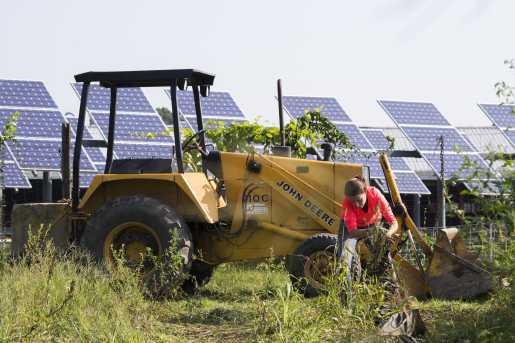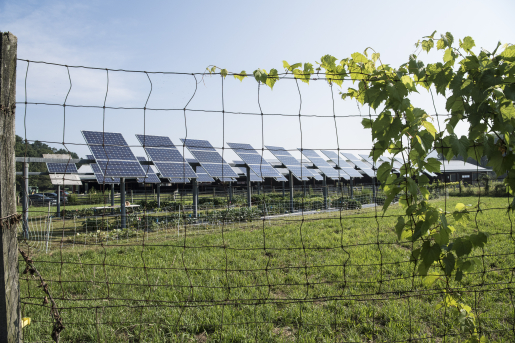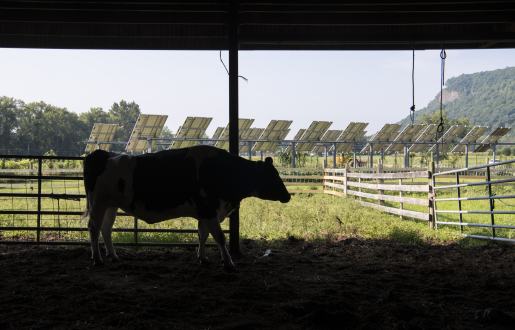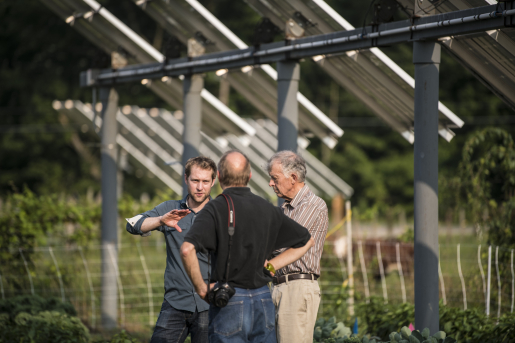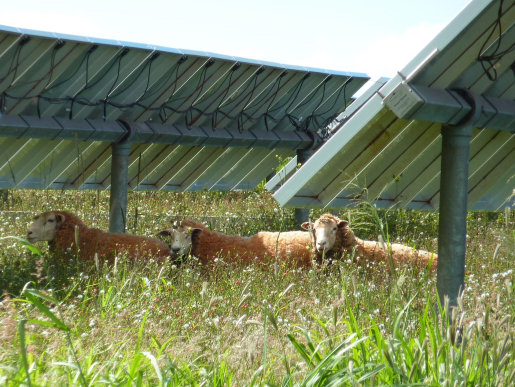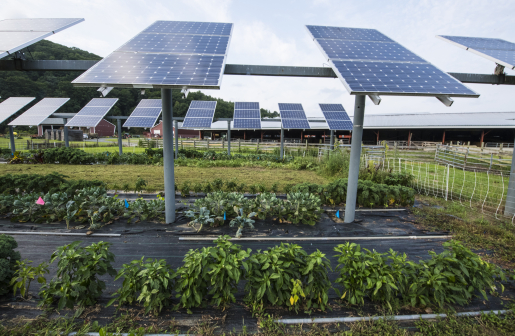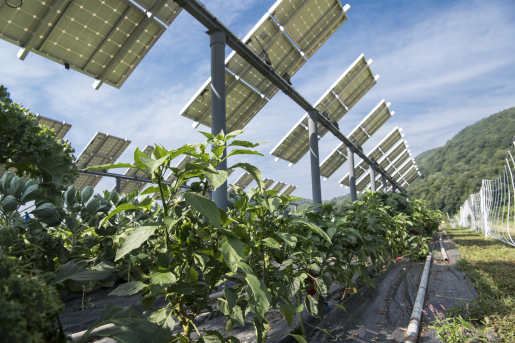AgriSolar Clearinghouse provides resources to support farmers and stakeholders interested in co-locating.
Farmers can benefit from solar energy in several ways—by leasing farmland for solar; installing a solar system on a house, barn, or other building; or through agrivoltaics. Agrivoltaics is defined as agriculture, such as crop production, livestock grazing, and pollinator habitat, located underneath solar panels and/or between rows of solar panels. Solar energy offers farmers the opportunity to harvest the sun twice—the same reason land is good for farming (flat, open areas), also makes it good for solar installations. The Solar Energy Technologies Office (SETO) is researching the opportunities and trade-offs of agrivoltaics. This guide helps answer some questions that farmers may have about going solar and agrivoltaics.
Getting Started
According to the DOE’s Solar Futures Study, the United States will need to double the amount of solar energy installed per year between 2025 and 2030 to decarbonize the electricity sector by 2035. Locating solar energy on farmland could significantly increase the available land for solar development, while maintaining land in agricultural production and expanding economic opportunities for farmers, rural communities, and the solar industry.
- Potential benefits for farmers include diversifying revenue and increasing farm profitability; on-farm energy production; reducing irrigation water needs by shading the plants; improving crop yield, especially in dry or hot areas; and improving crop resistance to extreme weather, such as droughts. Shade under solar panels can also enable the production of high-value crops that may not normally be grown in the local market (e.g., lettuces in desert areas), providing further opportunities for revenue.
- Potential benefits for rural communities include creating jobs, expanding access to clean electricity, and improving food security.
- Potential benefits for the solar industry include making siting of solar facilities easier, improving PV panel performance by cooling the panels, and lowering solar operation and maintenance costs by managing landscapes through farming instead of dedicated mowing or herbicide.
Read more about the potential of agrivoltaics for the U.S. solar industry, farmers, and communities. You can also read about our research on agrivoltaics through the National Renewable Energy Laboratory’s InSPIRE project, which includes an agrivoltaics primer, published research portal, and map of agrivoltaic sites in the United States.
Farmers interested in learning more about agrivoltaics can visit the AgriSolar Clearinghouse, which connects farmers, land managers, and researchers with trusted resources to support the growth of co-located solar and sustainable agriculture. The AgriSolar Clearinghouse also offers a helpful guide on getting started with agrivoltaics.
The height of photovoltaic (PV) panels can be raised to allow for easier access to crops. Raising the height of PV panels, however, can increase the cost of the solar installation due to the need for additional steel for the foundational posts. The length of steel foundational posts underground may also need to be increased to accommodate the additional wind loading.
Another common way to adapt the design of a solar installation for agrivoltaics is to increase the spacing between panels and between rows, which allows for additional sunlight to reach the crops and increases the accessibility of the site to equipment. Increasing spacing, however, decreases the amount of electricity that can be produced on a given piece of land, so there is a trade-off between solar and agricultural productivity.
There is significant opportunity to produce large amounts of solar energy on farmland. Agricultural land in the U.S. has the technical potential to provide 27 terawatts of solar energy capacity. This is a quarter of the total U.S. solar energy capacity of 115 TW. Only 0.3% of farmland is expected to be used for solar energy by 2035.
There is no documented evidence of solar panels increasing food prices. However, there is potential to use agrivoltaics branding on crops to increase the desirability of products. This could result in the products commanding higher prices.
Financing
The Agrisolar Clearinghouse has an interactive map that identifies federal, state, and local financial incentives, tax breaks, and other relevant financial programs that support agrivoltaics. Federal tax credits like the 30% investment tax credit are available to homeowners and businesses, and you should check with a tax expert for financial guidance on how to access these incentives. For example, businesses are eligible for additional credits, such as the energy community bonus, which are not available to homeowners.
The average lease payment for solar installations can vary based on several factors, including the size of the solar installation, location, and specific terms negotiated with the solar developer. Lease payments are typically structured as a fixed annual, monthly fee per acre, or a percentage of the energy generated by the solar panels. Contact solar developers in your area for more information.
Depending on the lease terms, ground-mounted solar may or may not be allowed on the site. If it is allowed and current farming operations are suitable for a ground-mounted solar PV array or if unused land exists, ground-mounted solar PV may be an option.
Installation
When considering the ground-mounted solar energy, it is also important to consider soil compaction and its effects on soil health. Heavy equipment used during installation can exacerbate compaction, which reduces pore space in the soil, limiting water infiltration and root growth. These effects can be reduced through the utilization of low-impact site preparation and construction techniques, as well as decompacting soils after construction. Developers can use software to model preconstruction grading needs and choose the appropriate torque tube height and racking systems for the specific area in order to minimize soil compaction.
Solar facilities can be designed with increased spacing between rows to allow for access with small tractors or other farm equipment. There is no one-size-fits-all solar design and developers should account for land and farming needs in the design process.
You should not burn crops underneath or around solar installations; this could lead to electrical fires and damaged equipment. If there is a need to conduct annual burns, this should be communicated to the solar developer upfront during the site selection process.
Solar can be installed in flood plains, but all electrical equipment will have to be installed above the projected level of flooding. Raising equipment could increase the cost of installation and may negatively impact the project economics. Also, the cost of insurance could be higher for PV systems in a flooding area. Areas that do not flood may be better suited for PV installations.
Cable management—which is the organization of cables connected to electrical devices—is crucial for ensuring the efficiency of the solar installation and minimizing the impact on agricultural activities. The preferable cable management technique depends on your specific needs, aesthetic considerations, safety concerns, budget constraints, and local regulations. Options for cable management include:
- Trenching: This involves digging trenches to bury cables below the ground. This minimizes visual impact and protects the cables from physical damage and weathering. Cable conduits are often used within trenches, adding an extra level of protection and making future maintenance or upgrades more accessible.
- Aerial Mounting: This involves suspending the cables above the ground on racks or poles. This can simplify maintenance and reduce the need for extensive ground disturbance, as well as keep the cables out of reach from wildlife. Cable clips can be used to secure the cables and minimize the risk of damage while keeping the cables organized.
- Hybrid Approach: In some cases, burying cables in certain areas where they are more susceptible to potential damage, while keeping them exposed in others.
Consulting with a solar developer, considering the impact on agricultural activities, and evaluating long-term maintenance requirements will help you determine the most suitable cable management approach to take.
Operation and Maintenance
Herbicide is currently sprayed at some solar facilities to prevent weed growth. Agrochemicals should not present an issue. Care should be taken to not spray panels themselves, but if it occurs, the panels can be washed off with water as they are made of glass and steel or aluminum and have been designed to withstand outdoor conditions.
Yes, solar can power irrigation equipment. Solar can offset power required for pumping and provide power to remote irrigation systems, requiring no grid connection.
If agricultural or grazing activities require equipment, machinery, or fencing, it is essential that these items are compatible with the solar design and configuration and will not lead to solar infrastructure damage. This not only includes consideration of panel heights and inter-row spacings, but also whether or not equipment would need to be attached to any part of the solar infrastructure, especially moving parts of tracking systems. Compact and low-profile machinery can allow for navigation between solar panels without causing damage. Automated or GPS-guided machinery can also be used to enhance precision and reduce the need for manual intervention, making it easier to navigate the layout of the solar panel system.
Adjacent agricultural activities can lead to increased soiling on panels from airborne dust and particulates generated during tilling, planting, or harvesting activities, or through pollen released by crops such as corn. Power generation loss due to soiling should be incorporated into PV system generation estimates. NREL’s PVWatts soiling calculator assumes that on average, 2% of power potential will be lost to soiling, but these losses are highly dependent on local weather and soiling conditions.
Land can be converted back to agricultural uses at the end of the operational life for solar installations, roughly 30 years. Depending on the solar operation, crops may or may not be present in the soil during the lifetime of the facility. Giving soil a rest can maintain soil quality and contribute to the biodiversity of agricultural land. On the other hand, implementing agrivoltaics and planting crops such as legumes underneath the solar installation can increase nutrient levels in the soil.
Sheep are grazed at some solar facilities in the United States and Europe. For grazing systems, most standard utility-scale solar panel heights can accommodate sheep grazing, but elevated panel heights are generally needed for cattle grazing. Research to facilitate cattle grazing under solar arrays is ongoing.
For all animals, wire management systems should be properly encased to avoid interactions with the animals. In many cases, traditional utility-scale solar infrastructure does not need to be modified significantly to support livestock grazing. According to data gathered by NREL’s InSPIRE project, as of November 2023, over 4,000 megawatts of power generated by solar panels in the United States include sheep grazing underneath. Solar operators can benefit from sheep grazing through a reduced need for mowing, herbicide, and other vegetation management needs at the site. Local shepherds may also benefit through payment for managing the grazing.
Crop and Soil Health
Silicon-based PV cells are the most common solar PV technology. Most solar panels have a glass layer on top that protects the PV cell and an aluminum or steel frame. An Electric Power Research Institute report found that “leaching of trace metals from modules is unlikely to present a significant risk due to the sealed nature of the installed cells.”
Some solar modules use cadmium telluride (CdTe). Cadmium compounds are toxic, but studies show that such compounds cannot be released from CdTe modules during normal operation or even during fires. Industrial incineration temperatures, which are much higher than grassfires, are required to release the compounds from the modules.
In some cases, agrivoltaics can improve soil health. For example, grazing sheep beneath solar panels has been shown to increase the soil organic carbon uptake. Letting the soil sit can also improve soil health.
Microclimate effects depend on the design of the solar system and the surrounding environment. Air temperatures tend to be cooler under the panels during the day and warmer under the panels at night. One study found that soil temperatures under the panels were less than that of soil temperatures in full sun all day and higher at night. There have been no studies linking solar development with pest problems or invasive species, but studies have shown that crops and native plants can thrive underneath solar installations.
Agrivoltaics can enable farmers to grow shade-tolerant crops and to diversify crop selection, while also extending growing seasons and reducing water requirements. Solar panels can cool crops and vegetation underneath during the day due to shading and keep them warmer at night. Some studies have shown that these temperature differences cancel each other out, so that daily average crop temperatures are similar under panels compared to full sun crops. High temperatures are often detrimental to crop yields. One study found that shading from solar panels produced lettuce crop weight equal to or greater than lettuce grown in full sun. In other cases, depending on the crops and growing conditions, impacts on yields can be more nuanced and depend on system design.
Yes, solar installations can support native vegetation and pollinator habitat species. Low-height plants can thrive underneath solar panels, avoiding the need for mowing and keeping the panels unshaded. Fifteen states are using state-specific Pollinator-Friendly Scorecards to promote planting of pollinator habitat underneath ground-mounted solar projects. Over thirty states are using state-neutral scorecards. Pollinator habitat under solar arrays can benefit farms by increasing local agricultural yield and can also host beekeeping operations.
A total of 15 state scorecards and one nonspecific scorecard available
A SETO-funded project led by the University of Illinois Chicago is studying the economic, ecological, and performance impacts of pollinator plantings co-located at five solar PV facilities (10 megawatts or larger) in the Midwest and Mid-Atlantic regions. The project is developing guidance and decision-making tools, such as a pollinator planting manual, cost-benefit calculator, and native seed mix selection tool, for solar developers and landowners.
For more information about pollinator-friendly standards and practices for solar sites, visit the Center for Pollinators in Energy website.
Learn about the benefits of establishing pollinator-friendly plants under and around ground-mounted solar arrays.
Learn More
Read “The 5 C’s of Agrivoltaics Success” from the National Renewable Energy Laboratory’s InSPIRE project, which uses insights from agrivoltaic field research to identify lessons that enable appropriate agrivoltaic deployment, successful research, and effective partnerships.
In early 2024, the U.S. Department of Agriculture (USDA) and DOE held American Farms, Rural Benefits virtual listening sessions to better understand the impact of renewable energy development on farmers and rural communities. Learn more about these resources.
Learn more about SETO's agrivoltaics research, see other solar energy resources for professionals, and check out our agrivoltaics blog posts below.
-
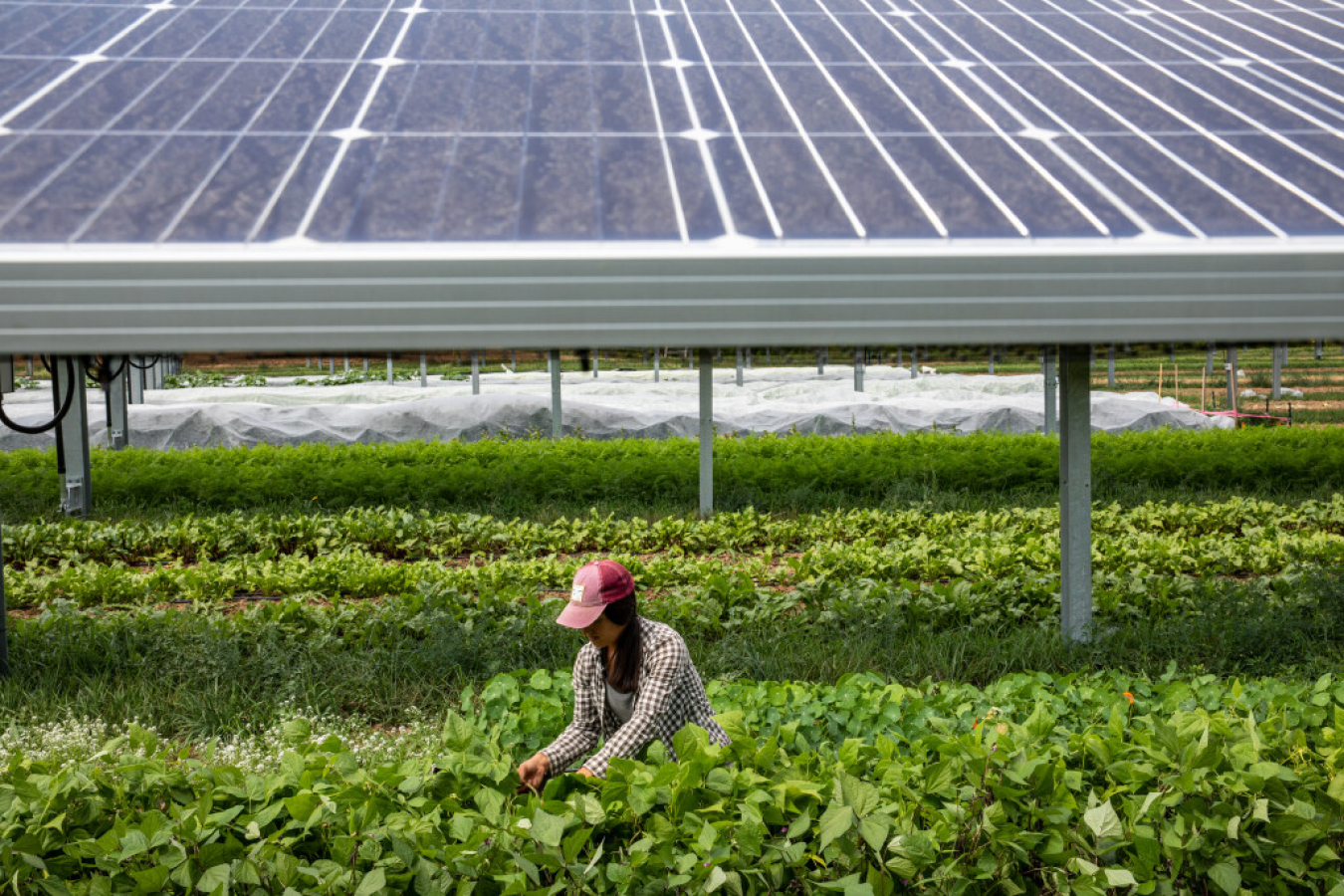 To make agrivoltaics a widely available option for developers in the U.S., questions about cost, liability and other business, legal and regulatory issues need to be addressed.
To make agrivoltaics a widely available option for developers in the U.S., questions about cost, liability and other business, legal and regulatory issues need to be addressed. -
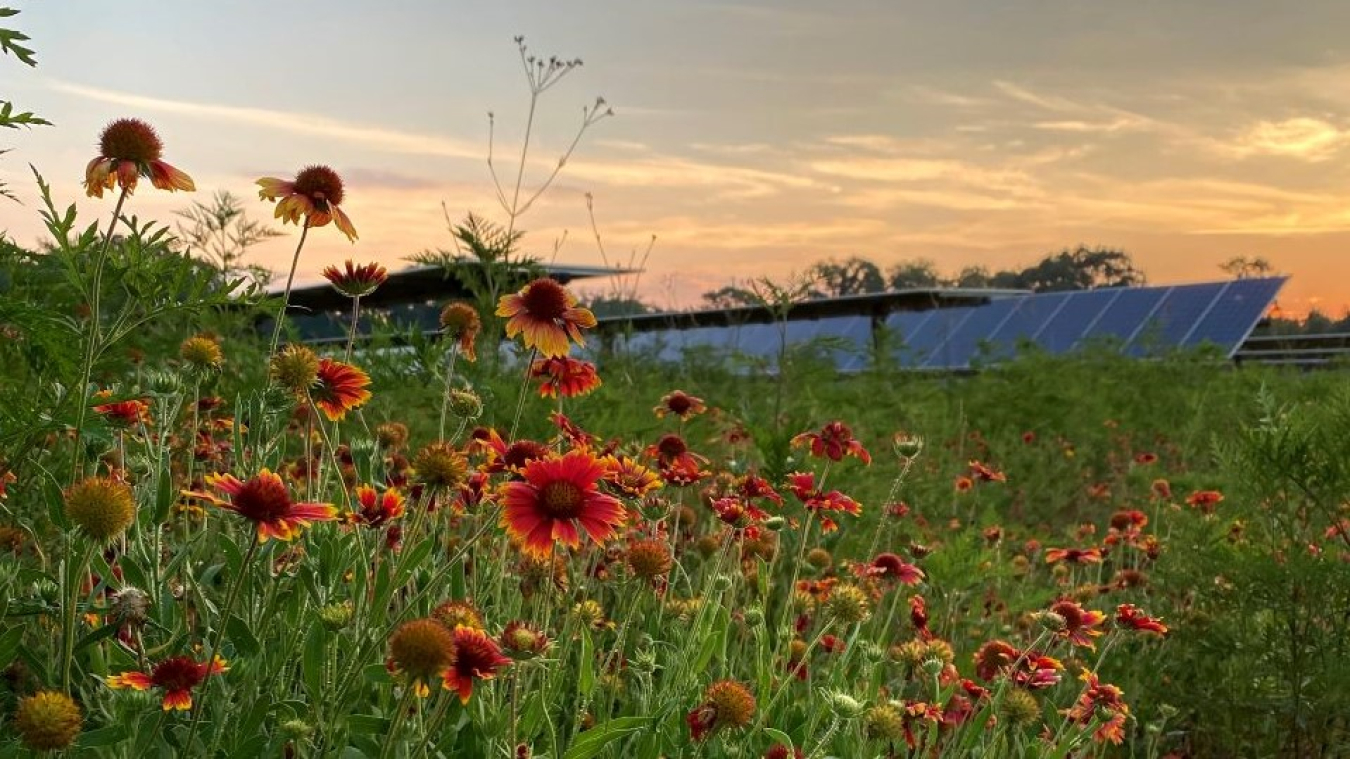 Pollinators—such as bees, butterflies, and other insects—are critical to the success of about 35 percent of global food crop production. Learn about the benefits of establishing pollinator-friendly plants under and around ground-mounted solar arrays.
Pollinators—such as bees, butterflies, and other insects—are critical to the success of about 35 percent of global food crop production. Learn about the benefits of establishing pollinator-friendly plants under and around ground-mounted solar arrays.


